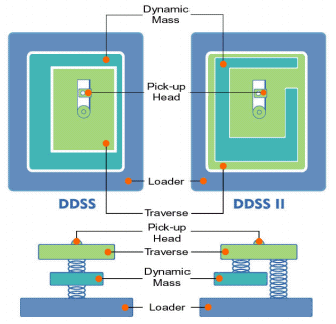ASUS CRW-4012A-U: High Speed Mobile Burning
by Kristopher Kubicki on November 6, 2002 5:03 AM EST- Posted in
- Storage
Features
Several years ago, when CD burners first got to the market, there was a slight problem called buffer underrun. Even in modern burners today, if the drive’s buffer reaches 0% while burner, the CD being written to is rendered a coaster. Eventually, BurnProof came along as a way to suspend the burn if the buffer dropped too low. As this technology became increasingly popular, ASUS along with other companies have begun to patent their own incarnation of BurnProof technology. FlextraLink is not much different than BurnProof aside from its slightly lower CPU consumption. Basically, when the burtn buffer drops to 1%, FlextraLink suspends the burn, and places a marker in memory where the burn left off. When the buffer is filled again, the burn continues.

While this feature is certainly great, notice the drive has only a 2MB buffer. FlextraLink certainly prevents the CDRW from burning constant coasters, but we would have liked to seen a larger buffer to prevent the necessity of such a feature.
Just like FlextraLink, FlextraSpeed is another somewhat generic technology that ASUS has trademarked. By monitoring the read constantly, the CRW-4012A-U adjusts the write of the media as necessary to prevent writing too fast on a poor media. Essentially, this coaster-prevention technology does not let you burn 40X to a 24X media. Since most good software automatically does this anyway, this feature seems more or less a moot point in our opinion.
Perhaps the most interesting feature found on the 4012A-U is DDSS II. Although not exactly a new technology, DDSII is designed to minimize spindle vibration. A small mass holds the head of the spindle in place. Vibration from the spindle is absorbed by the dynamic mass. Since the head vibration is slightly damped, the high pitched whine that normal CDROM’s make should not be as audible with a drive that contains DDSSII. Furthermore, since the drive is vibrating less, the laser should get a more accurate write on the media, thus delivering good performance.

Another great feature of this drive came when we saw Ahead’s Nero Burning ROM included in the packaging. Obviously, this will only benefit those who plan on purchasing a retail version of the drive. Nevertheless, Nero has made a name for itself as great all around software for burning audio, video, data, now even limited DVD compilations as well. ASUS made a good decision to include this software.
Given all these features, the one thing missing from this drive seems to be Mount Rainier support (CD-MRW). CD-MRW is the newer CD-RW format functionality that acts as an extension to traditional CD-RW support. Essential, CD-MRW enables drag and drop support on the drive for background formatting and writing. The eventual goal of this technology is to create a seamless interaction between CDRW drives and the user. While not a crucial feature today, it is a developing technology and most likely become a standard feature on all drives in the future.










1 Comments
View All Comments
mkagarwal896 - Wednesday, August 30, 2017 - link
From this classical High Speed Mobile Burning from Latest Gaming Laptop, ASUS has improved a lot. http://promocodeclub.com/coolwinks-offers-coupons/